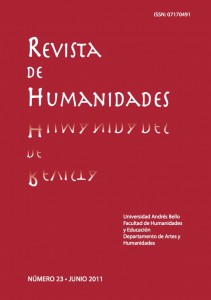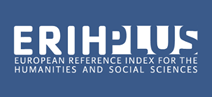Al sur de la frontera: historias de cowboys en Chile. Recepción y apropiación del cine western hollywoodense en los locos años 20
Palabras clave:
cultura de masas, norteamericanización, western, huaso-cowboy, nacionalismo chilenoResumen
En este trabajo se analiza cómo la sociedad chilena se inserta en el proceso de norteamericanización. Para lograrlo, proponemos estudiar la recepción del cine western y la forma como la sociedad chilena de la década de 1920 fue apropiándose del género. Bajo tal objetivo, analizaremos la forma en que el discurso del destino manifiesto y de la frontera del salvaje oeste interactúan con el nacionalismo chileno.
Descargas
Referencias
Appadurai, Arjun. Modernity at Large: Cultural Dimensions of Globalization. Minneapolis: University of Minnesota Press, 1998.
Barr Melej, Patrick. “Cowboys and Constructions: Nationalist Representations of Pastoral Life in Post-Portalian Chile. Journal of Latin American Studies 30.1 (1998).
Getino, Octavio. Cine y televisión en América Latina. Producción y mercados. Chile: LOM, 1998.
Kroes, Rob. “American Empire and Cultural Imperialism: A View from the Receiving End”. Diplomatic History 23.3 (1999): 463-497.
Latcham, Ricardo; Montenegro, Ernesto y Manuel Vega. El criollismo, Santiago: Universitaria, 1956.
Latorre, Mariano. “Algunas preguntas que no me han hecho sobre el criollismo”. Memorias y otras confidencias. Santiago: Editorial Andrés Bello, 1971. 46-59.
Ludmer, Josefina. El cuerpo del delito. Un manual. Buenos Aires: Perfil Libros, 1999.
Ossa, Carlos. Historia del Cine Chileno. Colección Nosotros los chilenos. Santiago: Editorial Quimantú, 1971.
Ossandón, Carlos y Eduardo Santa Cruz. El estallido de las formas. Chile en los albores de la “cultura de masas”. Santiago: LOM, 2005.
Pratt, Mary Louise. Imperial Eyes. Travel writing and transculturation. Londres: Routledge, 1992.
Purcell, Fernando. “Una mercancía irresistible. El cine norteamericano y su impacto en Chile, 1910-1930”. Historia Crítica 38 (2009): 46-69.
Rinke, Stefan. “Historia y nación en el cine chileno del siglo veinte”. Borrador inédito.
Rinke, Stefan. “Las torres de Babel del siglo XX: Cambio urbano, cultura de masas y Norteamericanización en Chile, 1918-1931”. Ampliando miradas. Chile y su historia en un tiempo global. Ed. Fernando Purcell. Santiago: RIL editores- Instituto de Historia PUC, 2009. 159-193.
Rinke, Stefan. Begegnungen mit dem Yankee: Nordamerikanisierung und soziokultureller Wandel in Chile, 1898-1990 [Encuentros con el Yanqui: Norte Americanización y cambio sociocultural en Chile, 1898-1990]. Lateinamerikanische Forschungen 32. Köln: Böhlau, 2004.
Santana, Alberto. Grandezas y miserias del cine chileno. Santiago: Editorial Misión, 1957.
Salvatore, Ricardo (comp.). Culturas imperiales. Experiencia y representación en América, Asia y África. Rosario: Beatriz Viterbo Editora, 2005.
Salvatore, Ricardo (comp.). Imágenes de un imperio. Estados Unidos y las formas de representación de América Latina. Buenos Aires: Editorial Sudamericana, 2006.
Skuban, William. “La apertura y el cierre de la frontera chileno-peruana: el plebiscito de Tacna y Arica, 1880-1929”. Ampliando miradas. Chile y su historia en un tiempo global. Eds. Purcell, Fernando y Alfredo Riquelme. Santiago: RIL editores-Instituto de Historia PUC, 2009. 129-158.
Slatta, Richard. Cowboys of the Americas. New Haven: Yale University Press, 1990.
Subercaseaux, Bernardo. Historia de las ideas y de la cultura en Chile. Tomo IV. Nacionalismo y cultura. Chile: Editorial Universitaria, 2007.
Weinberg, Albert K. Destino Manifiesto. El expansionismo nacionalista en la historia norteamericana. Argentina: Paidos, 1968.
Williams, Raymond. Marxism and Literature. Gran Bretaña: Oxford University Press, 1977.
Periódicos
El Mercurio, Santiago.
El Mercurio, Valparaíso.
El Corvo, Tacna.
Películas
Llorente, Alfredo. “El Leopardo”. Chile, 1926, 45 min.
Documentos
Wambaugh, Sarah. Plebiscites since the World War: with a Collection of official documents. Washington: Carnegie Endowment for International Peace, 1933.
Descargas
Publicado
Número
Sección
Licencia
Derechos de autor 2022 Revista de humanidades (Santiago. En línea)

Esta obra está bajo una licencia internacional Creative Commons Atribución-NoComercial-SinDerivadas 4.0.
You are free to:
- Share — copy and redistribute the material in any medium or format for any purpose, even commercially.
- Adapt — remix, transform, and build upon the material for any purpose, even commercially.
- The licensor cannot revoke these freedoms as long as you follow the license terms.
Under the following terms:
- Attribution — You must give appropriate credit , provide a link to the license, and indicate if changes were made . You may do so in any reasonable manner, but not in any way that suggests the licensor endorses you or your use.
- No additional restrictions — You may not apply legal terms or technological measures that legally restrict others from doing anything the license permits.
Notices:
You do not have to comply with the license for elements of the material in the public domain or where your use is permitted by an applicable exception or limitation .
No warranties are given. The license may not give you all of the permissions necessary for your intended use. For example, other rights such as publicity, privacy, or moral rights may limit how you use the material.













